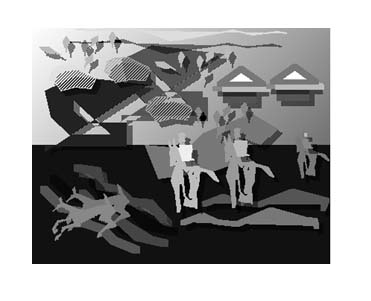

T h e P l a i n s


T h e P l a i n s
Watered by several large and numerous smaller rivers, its tracts of fertile land alternating with desert steppes have attracted a succession of primitive peoples, most nomadic, since very early times.
Excavations carried out in various sections of it have led to the discovery of artifacts dating as far back as 30,000 B.C. Some of the people who made them, such as the community associated with the site of Kostenki, just south of present-day Voronezh, or that far away to the east at Malta, slightly north of Irkutsk, to mention only two, were already able to fashion votive statuettes of artistic merit.
By the Neolithic Age, many sections of the Eurasian plain were inhabited by settlers who, though continuing to rely on their skill as hunters and fishermen for much of their food also, whether living in the region and period of the Ukraine's Tripolje culture or in parts of western Siberia, were engaged in cultivating the soil.
On the upper reaches of the Yenisei and in the Altaian lowlands, others had turned to pastoral occupations, domesticating sheep, goats, dogs, pigs and so on, learning to rear and care for them in order to improve their diet and to obtain regular supplies of wool, leather and felt. These advances were to result in the birth and establishment of nomadisim--a way of life which is wholly dependent on the ability of those practising it to maintain and control herds of domesticated animals.
By the first millennium BC nomadism was flourishing in the Eurasian plain. Though it [p. 9] embraced the whole of it, it may well have originated in its Asiatic section. By about the year AD 1000 it had spread across northern Iran and penetrated to Anatolia.
To this day, groups of nomads are occasionally encountered here and there in central Asia, Iran and Anatolia." [Artamonov, M.I. The Splendor of Scythian Art, Treasures from Scythian Tombs, with an introduction by Tamara Talbot Rice. New York: Frederick A. Praeger, Publishers. 1969]
Copyright, 2000